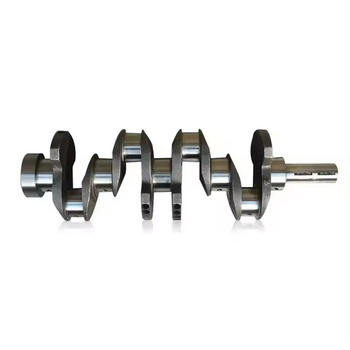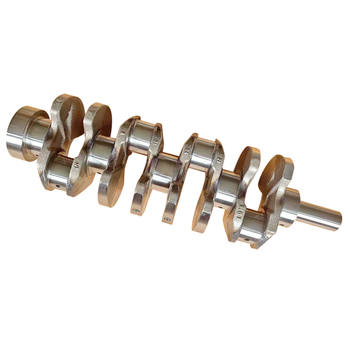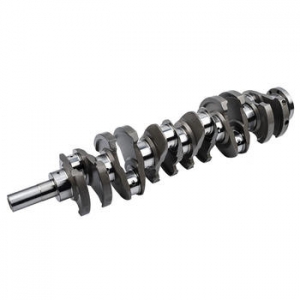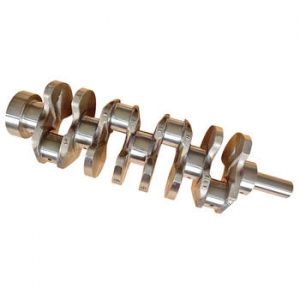Powering Progress: The Definitive Guide to Choosing Your Ideal Crankshaft Supplier
When it comes to the heart of any internal combustion engine, few components are as critical as the crankshaft. It’s the unsung hero, tirelessly converting the linear motion of pistons into rotational energy, ultimately driving everything from your daily commute to heavy industrial machinery. But behind every powerful engine lies a crucial partnership: the relationship with a top-tier crankshaft supplier. Frankly speaking, the quality of your crankshaft directly dictates the performance, longevity, and reliability of your entire engine system.
Have you ever stopped to consider the intricate engineering and precision manufacturing required to produce a component that withstands such immense forces and operates at such high RPMs? It's a testament to material science and manufacturing excellence. Choosing the right crankshaft supplier isn't merely a procurement decision; it's a strategic alliance that can define the success or failure of your product. In this comprehensive guide, we'll delve deep into what makes a great supplier, the types of crankshafts available, the manufacturing intricacies, and how to navigate the market to find your perfect match.
The Unsung Heroes of Power: Understanding the Role of a Crankshaft Supplier
At its core, a crankshaft is a mechanical part that translates reciprocating linear piston motion into rotational motion. It’s a complex piece of engineering, designed to handle extreme torsional and bending stresses. From automotive engines to marine propulsion systems, industrial compressors, and even power generators, crankshafts are ubiquitous in applications demanding robust power conversion. The role of a crankshaft supplier, therefore, extends far beyond simply delivering a part; they are responsible for providing a component that is the very backbone of an engine's operational integrity.
To be honest, the stakes are incredibly high. A faulty crankshaft can lead to catastrophic engine failure, resulting in significant financial losses, reputational damage, and even safety hazards. This is why the expertise, reliability, and quality control of your chosen supplier are paramount. A truly excellent supplier understands the critical nature of their product and invests heavily in research, development, and stringent quality assurance processes. They don't just sell crankshafts; they sell confidence and performance.
Many experts agree that the best suppliers act as partners, offering insights into material selection, design optimization, and manufacturing efficiencies. They are often involved in the early stages of engine design, providing valuable input that can save time and money in the long run. This collaborative approach is a hallmark of a forward-thinking crankshaft supplier.
Beyond the Basics: Types of Crankshafts and Their Applications
Crankshafts come in various forms, each tailored for specific applications and performance requirements. Understanding these distinctions is crucial when communicating your needs to a potential supplier. The primary differentiation often lies in the manufacturing method and the material used.
Forged vs. Cast Crankshafts
- Forged Crankshafts: These are typically made from steel alloys, heated, and then shaped under immense pressure. The forging process aligns the grain structure of the metal, resulting in superior strength, fatigue resistance, and durability. Forged crankshafts are preferred for high-performance engines, heavy-duty applications, and situations where extreme stress and longevity are critical, such as in racing engines or large industrial power units.
- Cast Crankshafts: Produced by pouring molten iron (often ductile iron) into a mold. While generally less expensive to manufacture than forged crankshafts, cast versions are also less strong and more brittle. They are commonly found in mass-produced, lower-stress engines, like those in many passenger vehicles, where cost-effectiveness and sufficient performance are the main drivers.
Materials and Design Variations
Beyond forging and casting, materials play a significant role. Steel alloys (like 4340 or 5140) are common for forged crankshafts due to their excellent strength-to-weight ratio and ability to withstand high temperatures and pressures. Ductile iron is the material of choice for most cast crankshafts, offering good machinability and vibration damping properties.
Design variations also exist, including different numbers of throws (journals for connecting rods), counterweights for balancing, and specific geometries to fit various engine configurations (e.g., inline, V-type, flat). A specialized crankshaft supplier will have expertise in designing and manufacturing these diverse types, including capabilities for producing high-performance crankshafts optimized for racing or extreme conditions.

What Makes a World-Class Crankshaft Supplier Stand Out?
Identifying a truly exceptional crankshaft supplier requires looking beyond just the price tag. It's about assessing their capabilities, commitment to quality, and their overall approach to partnership. In my experience, several key attributes consistently differentiate the best in the business.
Unwavering Commitment to Quality Control
This is non-negotiable. A top-tier supplier will have rigorous quality control protocols at every stage of the manufacturing process, from raw material inspection to final product verification. Look for certifications like ISO 9001, IATF 16949 (for automotive), or AS9100 (for aerospace), which demonstrate adherence to international quality management standards. They should employ advanced inspection techniques such as magnetic particle testing, ultrasonic testing, dimensional checks, and dynamic balancing to ensure every crankshaft meets precise specifications and is free from defects.
Advanced Manufacturing Capabilities
The best suppliers leverage cutting-edge technology. This includes precision CNC machining, advanced heat treatment processes (e.g., induction hardening, nitriding), and state-of-the-art grinding and polishing equipment. Their facilities should be modern, clean, and optimized for efficient, high-volume production without compromising on precision. The ability to handle complex geometries and tight tolerances is a strong indicator of their technical prowess.
Research and Development (R&D) and Innovation
A forward-thinking supplier doesn't just produce; they innovate. They invest in R&D to explore new materials, manufacturing techniques, and design improvements that can enhance performance, reduce weight, or improve durability. This commitment to innovation is particularly vital for clients seeking custom crankshaft manufacturing solutions or looking to stay ahead in competitive markets. They should be able to offer engineering support and collaborate on bespoke designs.
Robust Supply Chain and Logistics
Timely delivery and a secure supply chain are crucial. A reliable supplier will have well-established logistics, inventory management systems, and contingency plans to ensure consistent supply, even in challenging circumstances. Their ability to manage lead times, handle international shipping, and provide clear communication on order status is paramount.
Customer Service and Technical Support
Excellent customer service goes beyond just taking orders. It involves proactive communication, responsiveness to inquiries, and dedicated technical support. A good supplier will have a team of engineers and technical experts available to assist with design challenges, material selection, and troubleshooting. They should be willing to provide detailed documentation, test reports, and certifications for their products.
The Journey from Raw Material to Revolution: A Glimpse into Crankshaft Production
Understanding the manufacturing process of a crankshaft offers valuable insight into the capabilities of a crankshaft supplier. It's a multi-stage process demanding extreme precision and control at every step.
Material Selection and Preparation
The journey begins with selecting the appropriate raw material – typically a high-grade steel alloy for forged crankshafts or ductile iron for cast ones. This material is carefully inspected for purity and composition to ensure it meets the required metallurgical standards.
Forging or Casting
For forged crankshafts, steel billets are heated to high temperatures and then shaped using powerful presses and dies. This process refines the grain structure, enhancing strength and durability. For cast crankshafts, molten iron is poured into meticulously designed molds, allowed to cool, and then removed.
Initial Machining and Heat Treatment
After forging or casting, the crankshaft undergoes initial machining to remove excess material and achieve a rough shape. This is often followed by various heat treatment processes, such as normalization, quenching, and tempering. These treatments are critical for achieving the desired hardness, strength, and toughness throughout the component. Surface hardening techniques like induction hardening or nitriding are often applied to bearing surfaces to improve wear resistance.

Precision Machining and Grinding
This is where the crankshaft takes its final form. Advanced CNC machines precisely mill, drill, and turn the crankshaft to exact dimensions. The critical bearing surfaces (main journals and rod journals) are then ground to incredibly tight tolerances and polished to a mirror-like finish to minimize friction and wear during operation.
Balancing and Final Inspection
Due to the high rotational speeds and the need for smooth engine operation, crankshafts must be perfectly balanced. Dynamic balancing machines are used to detect and correct any imbalances by removing small amounts of material or adding counterweights. Finally, each crankshaft undergoes a comprehensive final inspection, including dimensional checks, surface finish analysis, magnetic particle inspection for cracks, and often ultrasonic testing to detect internal flaws. Only after passing these rigorous checks is the crankshaft ready for shipment.
It's worth noting that a truly proficient crankshaft supplier will have mastery over each of these stages, often utilizing proprietary techniques and advanced automation to ensure consistency and quality at scale.
Navigating the Market: Choosing the Right Crankshaft Supplier for Your Needs
With numerous suppliers in the market, selecting the right one can feel daunting. However, by focusing on key criteria and conducting thorough due diligence, you can make an informed decision that benefits your business in the long run.
Assess Their Reputation and Track Record
Start by researching the supplier's reputation. Look for testimonials, case studies, and industry reviews. Ask for references from existing clients, especially those with similar needs to yours. A long history of successful projects and satisfied customers is a strong indicator of reliability. Many experts agree that a supplier's reputation is built on consistent performance and integrity.
Evaluate Their Technical Capabilities and Expertise
Does the supplier have the technical prowess to meet your specific requirements? If you need custom crankshaft manufacturing, do they have in-house design and engineering teams? Can they work with a variety of materials and produce crankshafts for your specific engine type (e.g., automotive, marine, industrial)? A site visit to their manufacturing facility, if feasible, can provide invaluable insights into their operations, equipment, and quality control processes.
Consider Cost vs. Value
While price is always a factor, it shouldn't be the sole determinant. A cheaper crankshaft might lead to higher costs down the line due to premature failure, warranty claims, or reputational damage. Focus on the overall value proposition: the quality of the product, the reliability of supply, the level of technical support, and the potential for a long-term partnership. A reliable engine parts supplier offers a balance of competitive pricing and uncompromising quality.
Logistics, Lead Times, and Communication
Discuss their typical lead times for production and delivery. How do they handle urgent orders or unexpected changes? What are their shipping capabilities, especially if you require international delivery? Clear, consistent communication is vital. A good supplier will keep you informed at every stage, from order confirmation to dispatch.
Long-Term Partnership Potential
Consider if the supplier is interested in a long-term relationship rather than just a one-off transaction. A strong partnership can lead to mutual benefits, including shared innovation, cost efficiencies, and streamlined supply chains. Look for a supplier who is willing to grow with your business and adapt to your evolving needs.
Frankly speaking, finding the right crankshaft supplier is an investment in your product's future. It requires careful consideration, thorough vetting, and a clear understanding of your own requirements.
The Road Ahead: Innovations and Future Trends in Crankshaft Supply
The world of engine components is constantly evolving, driven by demands for higher efficiency, reduced emissions, and enhanced durability. The best crankshaft supplier will not only meet current needs but also anticipate future trends.
Lightweighting and Advanced Materials
As industries push for better fuel economy and reduced environmental impact, there's a growing emphasis on lightweighting components. This involves exploring advanced materials like high-strength steel alloys, composites, or even hybrid designs that offer superior strength-to-weight ratios. Suppliers investing in research for these materials will be at the forefront.
Additive Manufacturing (3D Printing)
While not yet mainstream for mass-produced crankshafts, additive manufacturing holds promise for prototyping, specialized designs, and potentially even small-batch production of highly complex geometries. A forward-thinking supplier might be experimenting with these technologies to offer more customized or rapidly prototyped solutions.
Enhanced Durability and Surface Treatments
Innovations in surface treatments (e.g., advanced coatings, laser hardening) are continuously improving the wear resistance, fatigue life, and overall durability of crankshafts, allowing them to withstand even harsher operating conditions.

Digitalization and Smart Manufacturing
The adoption of Industry 4.0 principles, including IoT sensors, data analytics, and AI-driven quality control, is making manufacturing processes more efficient, precise, and transparent. Suppliers embracing these technologies can offer better traceability, predictive maintenance, and optimized production schedules.
Interestingly enough, the future of crankshaft supply isn't just about making the part stronger or lighter; it's also about making the entire supply chain smarter and more responsive. Partnering with a supplier who is actively engaged in these innovations can give your products a significant competitive edge.
In conclusion, the choice of your crankshaft supplier is a decision that reverberates throughout your entire product lifecycle. It impacts performance, reliability, cost, and ultimately, your brand's reputation. By prioritizing quality, technical capability, and a collaborative spirit, you can forge a partnership that powers your progress for years to come.
For more detailed information, please visit our official website:Crankshaft supplier
About the author: Dr. Alistair Finch is a veteran mechanical engineer with over 25 years of experience in powertrain design and manufacturing. Specializing in rotating machinery and material science, his expertise spans automotive, marine, and industrial applications. Dr. Finch has consulted for numerous leading engine manufacturers, advising on component optimization and supply chain resilience. He is passionate about precision engineering and the critical role of high-quality suppliers in driving innovation.
 Trusted Crankshaft company Man
Trusted Crankshaft company Man
 Professional Crankshaft Manufa
Professional Crankshaft Manufa
 Trusted Crankshaft Supplier: W
Trusted Crankshaft Supplier: W
 Trusted Crankshaft Manufacture
Trusted Crankshaft Manufacture
